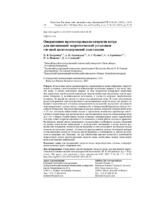| dc.contributor.author | Матренин, П. В. | |
| dc.contributor.author | Хальясмаа, А. И. | |
| dc.contributor.author | Русина, А. Г. | |
| dc.contributor.author | Ерошенко, С. А. | |
| dc.contributor.author | Попкова, Н. А. | |
| dc.contributor.author | Секацкий, Д. А. | |
| dc.coverage.spatial | Минск | ru |
| dc.date.accessioned | 2023-02-09T13:09:03Z | |
| dc.date.available | 2023-02-09T13:09:03Z | |
| dc.date.issued | 2023 | |
| dc.identifier.citation | Оперативное прогнозирование скорости ветра для автономной энергетической установки тяговой железнодорожной подстанции = Operational Forecasting of Wind Speed for an Self-Contained Power Assembly of a Traction Substation / П. В. Матренин [и др.] // Известия высших учебных заведений и энергетических объединений СНГ. Энергетика. – 2023. – № 1. – С. 18-29. | ru |
| dc.identifier.uri | https://rep.bntu.by/handle/data/126117 | |
| dc.description.abstract | В настоящее время рассматриваются перспективы создания гибридных энергетических установок с использованием возобновляемых источников энергии, в том числе энергии ветра, и систем накопления энергии на базе технологий водородной энергетики. Для управления такой системой накопления энергии необходимо оперативное прогнозирование генерации от возобновляемых источников, в частности ветровых энергетических установок. Их выработка зависит от скорости и направления ветра. В статье представлены результаты решения задачи оперативного прогнозирования скорости ветра для проекта гибридной энергетической установки, направленной на повышение пропускной способности железнодорожного участка между станциями Яя и Ижморская (Кемеровская область Российской Федерации). Проанализированы почасовые данные скоростей и направлений ветра за 15 лет, построена нейросетевая модель и предложена компактная архитектура много- слойного перцептрона для краткосрочного прогнозирования скорости и направления ветра на 1 и 6 ч вперед. Разработанная модель позволяет минимизировать риски переобучения и потери точности прогнозирования из-за изменения условий работы модели со временем. Особенность данной статьи заключается в исследовании устойчивости модели, обученной на данных многолетних наблюдений, к долгосрочным изменениям, а также анализе возможностей повышения точности прогнозирования за счет регулярного дообучения модели на вновь поступающих данных. Установлен характер влияния размера обучающей выборки и самоадаптации модели на точность прогнозирования и устойчивость ее работы на горизонте в несколько лет. Показано, что для обеспечения высокой точности и устойчивости нейросетевой модели прогнозирования скорости ветра необходимы данные многолетних метеорологических наблюдений. | ru |
| dc.language.iso | ru | ru |
| dc.publisher | БНТУ | ru |
| dc.title | Оперативное прогнозирование скорости ветра для автономной энергетической установки тяговой железнодорожной подстанции | ru |
| dc.title.alternative | Operational Forecasting of Wind Speed for an Self-Contained Power Assembly of a Traction Substation | ru |
| dc.type | Article | ru |
| dc.identifier.doi | 10.21122/1029-7448-2023-66-1-18-29 | |
| local.description.annotation | Currently, the prospects of creating hybrid power assemblies using renewable energy sources, including wind energy, and energy storage systems based on hydrogen energy technologies are being considered. To control such an energy storage system, it is necessary to perform operational renewable sources generation forecasting, particularly forecasting of wind power assemblies. Their production depends on the speed and direction of the wind. The article presents the results of solving the problem of operational forecasting of wind speed for a hybrid power assembly project aimed at increasing the capacity of the railway section between Yaya and Izhmorskaya stations (Kemerovo region of the Russian Federation). Hourly data of wind speeds and directions for 15 years have been analyzed, a neural network model has been built, and a compact architecture of a multilayer perceptron has been proposed for short-term forecasting of wind speed and direction for 1 and 6 hours ahead. The model that has been developed allows minimizing the risks of overfitting and loss of forecasting accuracy due to changes in the operating conditions of the model over time. A specific feature of this work is the stability investigation of the model trained on the data of long-term observations to long-term changes, as well as the analysis of the possibilities of improving the accuracy of forecasting due to regular further training of the model on newly available data. The nature of the influence of the size of the training sample and the self-adaptation of the model on the accuracy of forecasting and the stability of its work on the horizon of several years has been established. It is shown that in order to ensure high accuracy and stability of the neural network model of wind speed forecasting, long-term meteorological observations data are required. | ru |

